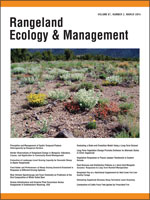Expansion of woody plants in North American grasslands and savannas is facilitated in part by root system adaptation to climatic extremes. Climatic extremes are predicted to become more common with global climate change and, as such, may accelerate woody expansion and/or infilling rates. We quantified root biomass and distribution patterns of the invasive woody legume, honey mesquite (Prosopis glandulosa), and associated grasses following a long-term rainfall manipulation experiment in a mixed grass savanna in the southern Great Plains (United States). Root systems of mature trees were containerized with vertical barriers installed to a depth of 270 cm, and soil moisture was manipulated with irrigation (Irrigated) or rainout shelters (Rainout). Other treatments included containerized, precipitation-only (Control) and noncontainerized, precipitation-only (Natural) trees. After 4 yr of treatment, soil cores to 270 cm depth were obtained, and mesquite root length density (RLD) and root mass, and grass root mass were quantified. Mesquite in the Rainout treatment increased coarse-root ( > 2 mm diameter) RLD and root mass at soil depths between 90 cm and 270 cm. In contrast, mesquite in the Irrigated treatment increased fine-root ( < 2 mm diameter) RLD and root mass between 30 cm and 270 cm depths, but did not increase total root mass (fine coarse) compared to the Control. Mesquite root-to-shoot mass ratio was 2.8 to 4.6 times greater in Rainout than the other treatments. Leaf water stress was greatest in the Rainout treatment in the first year, but not in subsequent years, possibly the result of increased root growth. Leaf water use efficiency was lowest in the Irrigated treatment. The increase in coarse root growth during extended drought substantially increased mesquite belowground biomass and suggests an important mechanism by which woody plant encroachment into grasslands may alter below ground carbon stocks under climate change scenarios predicted for this region.
How to translate text using browser tools
1 March 2014
Root Biomass and Distribution Patterns in a Semi-Arid Mesquite Savanna: Responses to Long-Term Rainfall Manipulation
R. J. Ansley,
T. W. Boutton,
P. W. Jacoby
ACCESS THE FULL ARTICLE

Rangeland Ecology and Management
Vol. 67 • No. 2
March 2014
Vol. 67 • No. 2
March 2014
carbon isotope ratio
carbon sequestration
climate change
Leaf water potential
root-to-shoot ratio
woody plant encroachment




